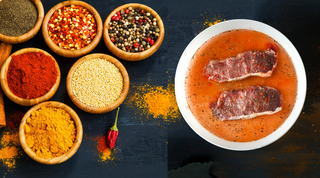Seasoning is the cornerstone of exceptional grilling. But with so many methods to choose from, how do you know when to reach for a marinade or rely on a dry rub? Each technique has its own strengths. Marinades deliver tenderness and subtle infusion over time, while rubs instantly build crust and concentrated flavor. In this extended guide, we’ll dive deeper into the science behind each approach, show you how to apply them for maximum impact, and provide advanced tips to elevate your grilling repertoire.
The Science of Marinades: Tenderness & Depth
A quality marinade typically includes three components:
-
Acid: Citrus juice, vinegar, or wine that breaks down muscle fibers, promoting tenderness.
-
Oil: Carries flavor compounds and helps keep the meat moist.
-
Aromatics & Spices: Herbs, garlic, ginger, soy sauce, or mustard to add depth and complexity.
Pro Tip: For lean meats like chicken breasts, marinating can significantly enhance moisture levels, ensuring juicy results on the grill.
Rubs: Concentrated Flavor & Crave-Worthy Crust
Rubs use dry spices and herbs to form a flavor-packed coating. Brown sugar, smoked paprika, kosher salt, black pepper, and chili powder are common bases. The key benefits of a rub are:
-
Immediate flavor payoff
-
Textural contrast, with a crusty bark forming as the rub caramelizes
-
No waiting around—apply just before cooking
Pro Tip: Apply rubs generously and pat them onto the surface rather than rubbing vigorously. This ensures an even layer that won’t clump or fall off.
When to Use Each Technique
-
Marinade: Ideal for lean proteins (chicken, pork loin, shrimp) and delicate cuts that need a moisture boost. Perfect for overnight prep.
-
Rub: Excellent for heartier cuts (brisket, ribs, steak) that can handle intense flavors and benefit from a rich, textured crust.
Combining Techniques for Layered Flavor
Why choose one when you can have both? Try a quick marinade for your chicken breasts, then pat them dry and add a light rub before grilling. The result is layers of flavor complexity and a multi-dimensional eating experience.
Avoiding Common Pitfalls
-
Over-Marinating: Leaving delicate fish in an acidic marinade for too long can result in mushy textures. Follow recommended marinating times for each protein.
-
Excess Salt in Rubs: Watch your salt ratios if your marinade or rub already includes salty components like soy sauce or pre-salted seasoning mixes.
Recommended Tools
-
Shallow Glass Dishes or Resealable Bags: For marinating without mess.
-
Measuring Spoons & Cups: Ensure precise rub ratios.
-
Basting Brushes: To apply leftover marinade as a glaze (only if boiled or kept separate to avoid cross-contamination).
FAQs: Marinades & Rubs
Q: Can I reuse marinade as a sauce?
A: Only if you boil it first to kill any bacteria, or if you set some aside before adding raw meat.
Q: Should rubs contain sugar?
A: Many rubs do include sugar for caramelization and balance, but it’s optional. Adjust sweetness to your taste.
Q: Can I freeze marinated meat?
A: Absolutely. Freezing actually helps the marinade penetrate more deeply. Thaw overnight in the fridge before grilling.
Mastering marinades and rubs puts you on the fast track to grilling greatness. By understanding how each method transforms texture and flavor, you can confidently choose the right approach—or even combine them—to create unforgettable meals. Experimentation is key, so don’t be afraid to play with seasonings, timing, and techniques until you hit the perfect flavor foundation for your favorite cuts.




